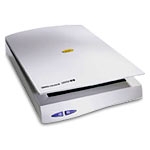HP Scanjet 3300C Scanner
Review
With all the hype surrounding ultra high resolution
digital cameras these days, it's rather easy to miss out on the latest
advancements in scanner technology. Digital cameras are very useful for taking
web based photos, but cannot do much for pictures already taken with a
film based camera. For these tasks, nothing beats a scanner.
 I'm sure
many of us can remember the early days of computer scanners. Unless money was no
object, flatbed scanners were typically out of reach (often costing thousands of
dollars). Instead, consumer level scanners were often small, hand held units that
scanned 256 shades of grey (although some could handle color). These scanners
were fairly difficult to use, because in order to scan most objects, a steady
hand was required. Even a slight deviation from a straight line could ruin an
otherwise decent scan.
I'm sure
many of us can remember the early days of computer scanners. Unless money was no
object, flatbed scanners were typically out of reach (often costing thousands of
dollars). Instead, consumer level scanners were often small, hand held units that
scanned 256 shades of grey (although some could handle color). These scanners
were fairly difficult to use, because in order to scan most objects, a steady
hand was required. Even a slight deviation from a straight line could ruin an
otherwise decent scan.
Thankfully, as with nearly everything else with
computers, things have changed. Flatbeds have improved in quality and speed,
while plummeting in price. Today, it's not uncommon to find scanners costing
$100 or less (in US dollars). These scanners typically have adequate resolution
and speed for consumer use, and some offer unique benefits such as one touch
scanning buttons and user friendly image editing software. With this in mind,
we'll be taking a look at one such scanner manufactured by Hewlett Packard; the
Scanjet 3300C. With a suggested price of $99 $129, it is clearly a candidate
for the "value" category. As we'll see, this particular scanner does indeed meet
the requirements of value scanners, while providing several extras useful to the
user.
Features and Specifications
Scanning
Type: Flatbed, color
Optical Scanning Resolution: 600
dpi
Max. Scanning Resolution: 9600 dpi
Color Processing:
36 bit
Max Scan Size: 8.5 x 11.7 inches
Connectivity:
USB
Automatic Document Feeder: None
Dimensions (W x D x H):
10 × 18 × 4 inches
Weight: 7.7 lb
Scan Speed:
90
secs: 4 × 6 in color photo to MS Word
180 secs: OCR letter size
B/W text to MS Word
150 secs: B/W line art to MS Word
In the past year, many
manufacturers have opted for the USB port rather than parallel or SCSI based
connections. USB offers a significant speed advantage over parallel, and is
often much easier to configure than SCSI (just plug it in, load the drivers, and
play). Considering this model is targeted at first time buyers, the decision to
go with USB was definitely a wise choice by HP. As for resolution, the key value
to note is the optical scanning resolution.
This
resolution is what the scanner sees natively, and should be used as a baseline
when comparing similar priced units. Going above this resolution (600 dots per
inch in this case) will result in interpolation, which in many cases can degrade
the quality of the image (since the hardware or software "guesses" at the extra
pixels by analyzing the pixels around a specific area).
One thing not mentioned in the
above specifications is the inclusion of two buttons on the front of the
scanner. These buttons allow for one touch scanning operation, and are user
programmable. The defaults are for initiating a scan and to copy an image (from
the scanner to a printer). Both rely on Windows 98's Still Image Monitoring
utility (STIMON.EXE), which is enabled on startup after installing the HP
drivers. These buttons can be programmed in the Scanners & Cameras applet in
Control Panel.
Considering I've
tested several USB devices here at PCstats, I was thinking the HP scanner
installation would be no different. As it turns out however, HP threw a
curve ball here, and the usual process is slightly different. In this case, the
drivers need to be installed BEFORE connecting the scanner for the first time.
This is a rather interesting issue, but I can confirm that the scanner won't
work unless this procedure is done. Luckily, HP does include a very helpful user
guide (and setup poster) that illustrates this.
Other than this,
installation proved to be rather uneventful. Upon loading the drivers, I
connected the scanner and Windows detected it. The next step depends on whether
the scanner is the 3300C, 3300Cse, or 3300Cxi model, as each comes with specific
software. The 3300C does not include any image editing software, while the Cse
and Cxi models come with Adobe Photodeluxe 2.0. The HP installation CD walks you
through installing this software, and will kindly prompt for the correct disc if
needed.
During the review of the 3300C, I installed Windows Millennium
Edition (Windows ME) on the test computer. While at first the scanning software
refused to install, a quick trip to HP's site
(https://www.hp.com/cposupport/nonjsnav/hpscanjet310443.html) reveals an update
that is available. installing this update proved to be very easy, and provided
full scanner support under microsoft's latest OS.

